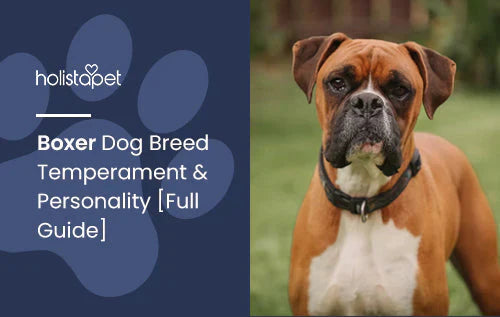Boxers are impressive dogs with square jaws and naturally lean bodies. They are known to be loving, loyal, energetic, intelligent, and great with children. Their personalities gave way to their rich history as bull baiters, police dogs, and faithful companions. At times, this breed can be headstrong and stubborn, which could pose a real challenge for first-time dog owners.
However, if you have the time and patience to train these beautiful dogs, they will reward you with a lifetime of love and devotion. We created this guide to help you determine if a boxer is the best dog breed for you.
Characteristics
A boxer's body is typically medium in size, with a sturdy back and muscular limbs. They have broad chests and shiny, short coats. A boxer's distinct squared-off head shape gives them their signature smile and name. Their square, blunt snouts tend to be smashed-in, which provides them with a soft, brave look.
They have naturally floppy ears and long tails, which adds to their appeal. It's also not uncommon to see these dogs with their ears and tails trimmed. However, several people consider ear and tail clipping harmful, making it very controversial in the dog community.
Size
The bodies of these dogs range from medium to large, depending on their gender. Male boxers are typically 23-25 inches in height, while females are a little smaller, averaging 21-23 inches in height. Males also tend to be heavier, weighing between 60-85lbs on average. Females are usually about 15lbs lighter. Regardless of gender, a boxer's size and loyalty make them ideal guard dogs and companions.
Personality
Boxer dogs personality are often rambunctious, silly, and incredibly energetic for the first three years of life. Although they settle down once fully mature, many adult boxers still display large amounts of energy. Throughout their lifespan, many of these dogs will also show traits of stubbornness. Impatience and unruly punishment can cause boxers to develop behavioral problems.

That said, the best way to manage this breed is with patience and positive reinforcement. Their headstrong boxer personality traits calls for a strong-willed owner who will discipline, train, and keep them on a steady schedule. This breed is known to get very attached to its owners. They love following their family and loved ones around the house since they dislike being alone.
They will protect the home and show extreme loyalty to their owners or pack (members of your household). Since this breed of first boxer is more prone to separation anxiety, they must get enough exercise and mental stimulation. A daily exercise routine is necessary for a boxer's emotional and physical health.
At times, this affectionate breed might see themselves as a lap dog. Despite their size, they will curl up on their loved ones just to be near them. Boxers can be suspicious of strangers at first, mainly because they are overprotective of their owners. However, they have a naturally timid Boxer temperament and personality unless their owners raise them differently.
How to Care for a Boxer
Exercise, grooming, and training are necessary when raising a boxer. If you keep up with these, everything else should be a walk in the park. Of course, regular vet visits, affection, and a high-quality diet are also essential to your dog's health. Let's focus on the three fundamental care categories separately.
Exercise
Running, jogging, playing fetch, mild wrestling, tug of war, and swimming are all great ways to exercise a boxer. Toys that require patience or memory, such as doggy puzzle games or chew toys with layers, are also great passive exercises to stimulate your dog's mind. Taking your boxer to the dog park is also highly recommended. They are a great place to work out a large breed because of the open space. Dog parks can also help improve your pet's socializing skills. Boxers need about 30 minutes of exercise a day to remain healthy and happy.
In some cases, the more exercise, the better. Keep in mind that if you live in a smaller home or in one without a yard, it might be more of a challenge to get your dog the exercise they need. Still, it can be done if you have the time and are committed to the daily task. If you can, it's best to allow your boxer an hour of exercise time every day. Activities can be broken up into several parts throughout the day since you also don't want to overexert your dog. Just like in humans, overexertion can lead to injury in dogs.
Dogs place around 60% of their weight on their front limbs, which puts a lot of pressure on those joints. High-intensity running, jumping, or wrestling can also cause extra wear and tear on these front limbs. When done right, enough exercise can mean a longer living, healthier, and happier pet. If you're unsure how much exercise time your dog needs, a trip to the vet can help.
Grooming
Boxers typically do not need much grooming since their short, generally polished coats are easy to manage. Keeping a steady rubber brush on hand for at-home grooming sessions is a good idea. Brushing their coat for five minutes once or twice a week can help with excess shedding. Interestingly enough, boxers are one of the few dog breeds that are good at cleaning themselves. Their self-grooming means one monthly bath will do the trick unless they get themselves in a messy situation.
When it comes to their nails, they should be clipped once a month. If your boxer spends a lot of time outside or running around, they may naturally wear them down. However, it's always best to make sure their nails don't get too long since that can lead to injury. Finally, oral health can be tricky with a boxer. This breed's teeth appear to be different than most other dogs. Boxers tend to have a slight upward curve in their jawline that often leads to teeth that don't emerge from the gums.
Because their teeth don't fully break through their gums, the awkward teeth placement may cause them to bite tiny holes in their gums. So, it's crucial to brush their teeth daily. A consistent oral routine can help prevent plaque and tartar build-up. It can also help you notice any dental hygiene issues in advance. Giving them dental chew toys or treats can also help maintain healthy gums and clean their teeth.
Training
Boxers are quick learners, which can make things a little easier for owners. As we briefly mentioned earlier, boxers are determined dogs that can be stubborn at times. So, a person who has never experienced stubbornness in a dog may have more difficulty training it. Although a new dog owner can raise a well-behaved dog, it can be helpful to have prior experience. Training a boxer usually requires a lot of patience, understanding, and consistency.
This breed especially will not respond well to negativity or stressful corrections. Providing encouragement, consistency, repetition, and positive reinforcement are crucial elements of training a boxer. Many owners find that training a boxer can be incredibly rewarding because of the bond and trust it builds. As a respected leader, a boxer will, in time, look up to their owner to set guidelines they undoubtedly follow. Owners have found that leash training is the hardest part of training this breed.

Boxers are powerful dogs that will naturally pull or yank as they try to walk well past their owner. Another difficult habit to break in a boxer is their need to jump on people. For them, jumping on someone they care about is a way to display their love and affection. The best way to curb any behavioral issue is to work on it as early as possible. Many tips, tricks, and training methods can help with leash training or jumping. Finding a solution for any bad habit might take time and experimentation. And, of course, a lot of love and patience.
History
Boxers have a long history, dating back to ancient times. They are descendants of the great war dogs of the Assyrian Empire, although their bloodline goes back to Germany. In the late 1800s, Germans bred bullenbeissers, energetic dogs meant for bull baiting. Germans also used bullenbeissers as big-game hunters. They track and hunt down bears, wild boar, bison, and other large animals.
Tracking and hunting dogs of this size and power were mostly owned by the rich, who would hold large hunting expeditions on their vast properties. Because Bullenbeissers were prevalent among the rich, the downfall of nobility in Germany made the breed's popularity decline. Soon after, Bullenbeissers were crossbred to the point of extinction.
The crossing with mastiffs and old English bulldogs brought about the creation of boxers. The Boxer temperament became popular in Europe during World War I due to the Boxer's tracking skills, loyalty, and strength. After the end of the war, the popularity made its way to America. Across the U.S., boxers were seen as working dogs like German Shepherds. Now, boxers often became police dogs, seeing-eye dogs, lifeguards, and cattle herders, among other things.
Related Post: German Dog Breeds: 15 Most Iconic Dogs from Germany
Boxer Health Problems
Boxers are generally healthy dogs because of how naturally active they are. Still, there are a few conditions that boxers are more prone to getting. Boxers do not deal with extreme hot or cold weather, making them indoor dogs. Below is a list of some of boxer breeds' most common health problems.
Heart Issues
There have been cases of heart defects found in boxers. A narrowed aorta causes it that forces the heart to work overtime to pump blood. It is an inherited condition that vets can detect if caught soon enough. The heart issues can lead to fatigue, fainting, and serious complications.
Gas Problems
This happens when air or gas suddenly inflates or expands a boxer's stomach. This air or gas twists the stomach, keeping the boxer from burping or naturally getting rid of the gas. It also slows blood movement back to the heart and causes blood pressure to plummet. This can result in shock and requires immediate attention. Signs of gas issues include loss of interest, bloating, sadness, excessive drooling, and dry heaving without throwing anything up.
Hip Issues
Hip Issues are common amongst many dogs, including boxers. Many times it's hereditary, but outside factors might also cause it. This condition occurs when the thigh bone has trouble fitting into the hip joint. Some symptoms include changes in boxer behavior, appetite loss, and tiredness, among other things. Boxers may show signs of discomfort, but many will also hide their symptoms until it becomes overbearingly uncomfortable. In some cases, joint issues may develop from hip issues if it's left untreated for too long.
Related Product: Holistapet's #1 CBD Mobility Chews For Dogs
Hearing Issues
Hearing Issues tend to be a genetic condition in boxers. Almost one in five boxers have hearing issues. White boxers are more likely to have hearing issues than other colors. For more information on that, see the coat color section below.
Skin Issues
Mites usually cause these skin issues. It's more common for puppy boxers to have problems with skin issues and skin cancer than adult dogs. These mites live in dogs' skin and transfer instantly from mother to puppy during birth. This mite is usually not a problem unless the dog has a compromised immune system. If the dog has other underlying health risks, keeping these mites in check can be challenging. In sick dogs, the mite can multiply rapidly and cause itchiness and red spots. Excessive scratching may lead to secondary skin problems and hair loss.
Eye Problems
Eye issues typically cause opaque areas within the eye, which is very common in many dog breeds. Usually, both eyes will be affected. It is not heredity and is usually painless unless sores begin to appear. It doesn’t always affect a dog’s vision. However, an untreated and advanced version of this condition can lead to loss of sight.
Breathing Issues
Like all dogs, boxers are susceptible to breathing issues. Pollen, dust, mold, aerosol sprays, and food allergies are the most common. Breathing issues can cause several symptoms, including itchiness, hives, and excessive drooling. Unmanaged breathing issues may lead your boxer to develop dermatitis or other skin conditions. Boxer owners should read the Official Breed Club Health Statement for additional information on how to screen for these ailments and how to treat them.
Nutrition and Feeding for Boxers
Boxers must have a high-quality, protein-rich, and nutrient-dense diet. L-carnitine and calcium are among the essential nutrients your boxer's food should have. Since boxers are susceptible to food allergies, it's best to avoid ingredients that might cause any adverse reactions. Those ingredients include corn, soy, wheat, and yeast––none of which are necessary for a dog's health. You can also give Holistapet's CBD Oil for dogs for their better health. It's also a good idea to avoid artificial coloring, artificial flavoring, highly processed foods, and synthetic food ingredients.
Coat Color
There are three standard types of coat colors for boxers: white, fawn, and brindle. Although mixed breeds may have a broader range of coat colors, those are the standard three for purely bred boxer breeds. They also have some characteristic markings like a black mask, white markings, a black mask with white markings, brindle markings, and fawn markings. Below are some more details for the three most common boxer coats.
White Boxer
Entirely white boxers make up roughly 25% of all boxers. Their gorgeous white coat has made them very popular. Like we mentioned earlier, white boxers are more prone to be born deaf than other colors. This happens because of a lack of pigmentation in the ears and a loss of hair follicles.

Brindle Boxer
Brindle is a pattern instead of a color. It has light or dark stripes, similar to those of tigers. In many cases, the stripes are so dark that they are hard to see unless placed under direct light. Reverse Brindle boxer may also have some white markings on their paws and chest.
Fawn Boxer
Fawns can come in several types of hues, typically closer to brown or beige colors. Some fawns may be a darker brown color, while others are lighter or pale. Although you may have seen "black boxer dog" boxers online or in pet stores, it's most likely not what you think.The gene that turns a boxer coat black does not exist in the actual breed.
The first reason a boxer is black is that it's mixed with another breed. The second reason is that it has a dark fawn or brindle color with wide dark stripes making them appear black. There are circumstances where a boxer's coat appears black because of something called reverse brindle. In this case, the stripes are dominant and so thick that it is hard to tell there is a fawn coat as a backdrop.
Children and Other Pets
Boxers make great pets for owners with children. Often, these fierce dogs turn into putty next to a newborn baby or young child. Boxers often keep a close eye on young kids, making them great protectors. Since boxers are full of energy and love jumping on people to show affection, it's important to correct that behavior immediately. The size and strength of a boxer may be too much for a small child to handle.
As we mentioned earlier, this behavior must be corrected when they're puppies because they can be stubborn to learn new things as adult dogs. While boxers are known to be friendly to other pets, this all depends on what they learned as puppies. Dogs are all territorial. So, socializing them at a young age can help boxers welcome new pets in the home. Exposing a dog to different animals at a young age is always a great idea. A puppy boxer will more likely be friendly with cats than a one-year-old boxer who has never seen a cat. The older the dog gets, the less likely they are to be friendly with an unfamiliar animal.
Rescue Groups for Boxers
There are several official rescue groups for boxers and clubs nationwide. Across America Boxer Rescue, Adopt A Boxer Rescue, and Blue Ridge Boxer Rescue are some of the most popular and reputable rescue groups for boxers. American Boxer Club is excellent for finding rescue groups locally.
With that said, there are thousands of local groups doing fantastic work. If you are looking to adopt, it's a good idea to check your local ASPCA or high kill dog shelter first. The ASPCA focuses on getting orphan dogs into safe and healthy homes. By checking with the ASPCA, you can help save and adopt boxers that are on kill lists.
Boxer Breed Organizations
Thousands of local organizations in each state specialize in boxer treatment, safety, rescue, and education. The American Boxer Club is just one of many fantastic organizations that do incredible things for boxers.
More About This Dog Breed
Boxers make lovely pets. They are incredibly loyal, intelligent, energetic, and naturally friendly. However, their stubbornness and high energy level can be intimidating for first-time dog owners. Although new dog owners can undoubtedly train boxers, they must be very patient and consistent with their discipline. Boxers do not do well with negative reinforcement or frustrating corrections, which can also be tough to avoid for someone who's never trained a dog.
They can easily sense signs of faltering leadership or stress in owners. This breed needs a loving but stern alpha leader to guide them. Many owners find that successfully training a boxer comes with many rewards. Proper training enforces the bond and trust between a dog and its owner. If you feel like you can handle raising a boxer, you will experience loyalty, friendship, and lots of love from your furry friend. You can also learn about other breeds here.


 CBD Oil for Dogs - Fast Acting
CBD Oil for Dogs - Fast Acting
 Chicken Flavored CBD Oil For Dogs - Easy Dose
Chicken Flavored CBD Oil For Dogs - Easy Dose
 Salmon Flavored CBD Oil For Dogs - Highly Rated
Salmon Flavored CBD Oil For Dogs - Highly Rated
 CBG Oil for Dogs and Cats - Loved by Thousands
CBG Oil for Dogs and Cats - Loved by Thousands





Leave a comment
All comments are moderated before being published.
This site is protected by hCaptcha and the hCaptcha Privacy Policy and Terms of Service apply.